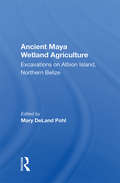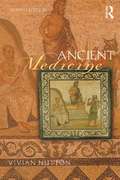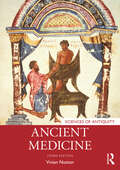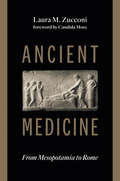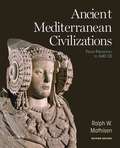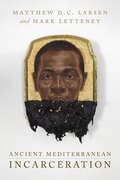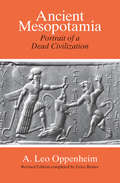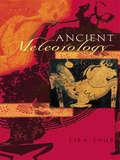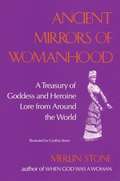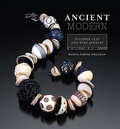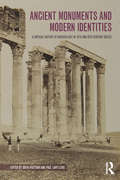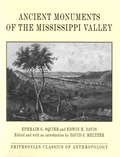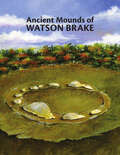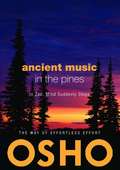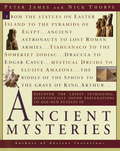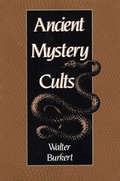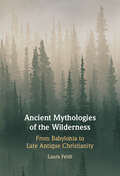- Table View
- List View
Ancient Maya Wetland Agriculture: Excavations On Albion Island, Northern Belize
by Mary Deland PohlChanges in the orientation of archaeological research in the post-World War n period affected Maya studies. The cultural ecological perspective, which was rising to prominence, put an old debate in bold relief: How had this prehistoric civilization adapted to the tropical forest environment? How could swidden cultivation have sustained the unexpectedly high population densities that settlement pattern studies appeared to be revealing? Had the ancient Maya practiced some from of intensive agriculture? Archaeologist Dennis E. Puleston went to the Maya Lowlands to investigate geographer Alfred H. Siemens's reports of possible intensive agriculture ("ridged fields") seen from the air and to study prehistoric Maya cultivation and civilization from a cultural ecological perspective. This volume presents the results of the Rio Hondo Project field research on Albion Island in northern Belize from 1973 to 1980 with the addition of selected results from Pohl's continuing work in northern Belize.
Ancient Medicine (Sciences of Antiquity)
by Vivian NuttonThe first edition of Ancient Medicine was the most complete examination of the medicine of the ancient world for a hundred years. The new edition includes the key discoveries made since the first edition, especially from important texts discovered in recent finds of papyri and manuscripts, making it the most comprehensive and up-to-date survey available. Vivian Nutton pays particular attention to the life and work of doctors in communities, links between medicine and magic, and examines the different approaches to medicine across the ancient world. The new edition includes more on Rufus and Galen as well as augmented information on Babylonia, Hellenistic medicine and Late Antiquity. With recently discovered texts made accessible for the first time, and providing new evidence, this broad exploration challenges currently held perspectives, and proves an invaluable resource for students of both classics and the history of medicine.
Ancient Medicine (Sciences of Antiquity)
by Vivian NuttonThe third edition of this magisterial account of medicine in the Greek and Roman worlds, written by the foremost expert on the subject, has been updated to incorporate the many new discoveries made in the field over the past decade. This revised volume includes discussions of several new or forgotten works by Galen and his contemporaries, as well as of new archaeological material. RNA analysis has expanded our understanding of disease in the ancient world; the book explores the consequences of this for sufferers, for example in creating disability. Nutton also expands upon the treatment of pre-Galenic medicine in Greece and Rome. In addition, subtitles and a chronology will make for easier student consultation, and the bibliography is substantially revised and updated, providing avenues for future student research. This third edition of Ancient Medicine will remain the definitive textbook on the subject for students of medicine in the classical world, and the history of medicine and science more broadly, with much to interest scholars in the field as well.
Ancient Medicine: From Mesopotamia to Rome
by Laura M. ZucconiThis book by Laura Zucconi is an accessible introductory text to the practice and theory of medicine in the ancient world. In contrast to other works that focus heavily on Greece and Rome, Zucconi&’s Ancient Medicine covers a broader geographical and chronological range. The world of medicine in antiquity consisted of a lot more than Hippocrates and Galen.Zucconi applies historical and anthropological methods to examine the medical cultures of not only Mesopotamia, Egypt, Greece, and Rome but also the Levant, the Anatolian Peninsula, and the Iranian Plateau. Devoting special attention to the fundamental relationship between medicine and theology, Zucconi&’s one-volume introduction brings the physicians, patients, procedures, medicines, and ideas of the past to light.
Ancient Medicine: From Mesopotamia to Rome
by Laura M. ZucconiThis book by Laura Zucconi is an accessible introductory text to the practice and theory of medicine in the ancient world. In contrast to other works that focus heavily on Greece and Rome, Zucconi&’s Ancient Medicine covers a broader geographical and chronological range. The world of medicine in antiquity consisted of a lot more than Hippocrates and Galen.Zucconi applies historical and anthropological methods to examine the medical cultures of not only Mesopotamia, Egypt, Greece, and Rome but also the Levant, the Anatolian Peninsula, and the Iranian Plateau. Devoting special attention to the fundamental relationship between medicine and theology, Zucconi&’s one-volume introduction brings the physicians, patients, procedures, medicines, and ideas of the past to light.
Ancient Mediterranean Civilizations: From Prehistory To 640 Ce
by Ralph MathisenChallenging the stereotypes and myths that typically characterize students' understanding of antiquity, Ancient Mediterranean Civilizations: From Prehistory to 640 CE, Second Edition, focuses on continuity and connections, along with cultural diffusion and cultural diversity, to show how history is a cumulative process and that numerous similar themes recur in different times and places. The text also explores sensitive issues and debates including attitudes toward race, ethnicity, and tolerance; gender issues and roles; slavery; social mobility; religion; political evolution; the nature of government; and imperialism.
Ancient Mediterranean Incarceration
by Mark Letteney Matthew D.C. LarsenA free ebook version of this title is available through Luminos, University of California Press’s Open Access publishing program. Visit www.luminosoa.org to learn more. This book examines spaces, practices, and ideologies of incarceration in the ancient Mediterranean basin from 300 BCE to 600 CE. Analyzing a wide range of sources—including legal texts, archaeological findings, documentary evidence, and visual materials—Matthew D. C. Larsen and Mark Letteney argue that prisons were integral to the social, political, and economic fabric of ancient societies. Ancient Mediterranean Incarceration traces a long history of carceral practices, considering ways in which the institution of prison has been fundamentally intertwined with issues of class, ethnicity, gender, and imperialism. By foregrounding the voices and experiences of the imprisoned, Larsen and Letteney demonstrate the extraordinary durability of carceral structures across time and call for a new historical consciousness around contemporary practices of incarceration.
Ancient Mesopotamia: Portrait of a Dead Civilization
by A. Leo Oppenheim"This splendid work of scholarship . . . sums up with economy and power all that the written record so far deciphered has to tell about the ancient and complementary civilizations of Babylon and Assyria."—Edward B. Garside, New York Times Book Review Ancient Mesopotamia—the area now called Iraq—has received less attention than ancient Egypt and other long-extinct and more spectacular civilizations. But numerous small clay tablets buried in the desert soil for thousands of years make it possible for us to know more about the people of ancient Mesopotamia than any other land in the early Near East. Professor Oppenheim, who studied these tablets for more than thirty years, used his intimate knowledge of long-dead languages to put together a distinctively personal picture of the Mesopotamians of some three thousand years ago. Following Oppenheim's death, Erica Reiner used the author's outline to complete the revisions he had begun. "To any serious student of Mesopotamian civilization, this is one of the most valuable books ever written."—Leonard Cottrell, Book Week "Leo Oppenheim has made a bold, brave, pioneering attempt to present a synthesis of the vast mass of philological and archaeological data that have accumulated over the past hundred years in the field of Assyriological research."—Samuel Noah Kramer, Archaeology A. Leo Oppenheim, one of the most distinguished Assyriologists of our time, was editor in charge of the Assyrian Dictionary of the Oriental Institute and John A. Wilson Professor of Oriental Studies at the University of Chicago.
Ancient Meteorology (Sciences of Antiquity)
by Liba TaubThe first book of its kind in English, Ancient Meteorology discusses Greek and Roman approaches and attitudes to this broad discipline, which in classical antiquity included not only 'weather', but occurrences such as earthquakes and comets that today would be regarded as geological, astronomical or seismological. The range and diversity of this literature highlights the question of scholarly authority in antiquity and illustrates how writers responded to the meteorological information presented by their literary predecessors. Ancient Meteorology will be a valuable reference tool for classicists and those with an interest in the history of science.
Ancient Mexico: An Introduction to the Pre-Hispanic Cultures
by Frederick A. PetersonGeneral introduction to pre-Columbian Mexico: history, politics, culture, arts, religion, economics, architecture, and mathematics.
Ancient Mirrors of Womanhood: A Treasury of Goddess and Heroine Lore from Around the World
by Merlin StoneThis is a book that provides some balance to the modern, predominantly patriarchal religions which view Deity as male. It is a collection of lore of the role of women in ancient cultures and religions, and is designed to give women a better sense of the role of the feminine throughout history. It is rich in symbolism, mystery, and lore. It is excellent food for any spirit, and is particularly affirming for women or anyone who celebrates the balance of feminine and masculine in life.
Ancient Models of Mind
by Andrea Nightingale David SedleyHow does god think? How, ideally, does a human mind function? Must a gap remain between these two paradigms of rationality? Such questions exercised the greatest ancient philosophers, including those featured in this book: Socrates, Plato, Aristotle, the Stoics and Plotinus. This volume encompasses a series of studies by leading scholars, revisiting key moments of ancient philosophy and highlighting the theme of human and divine rationality in both moral and cognitive psychology. The volume is a tribute to A. A. Long, and reflects multiple themes of his own work.
Ancient Modern: Polymer Clay And Wire Jewelry
by Ronna WeltmanWith Ancient Modern, learn to create organic, sophisticated, and distinctly contemporary jewelry by artistically combining polymer clay and wire.Use a range of innovative techniques to design beads and jewelry components from polymer clay.Add wireworking elements, inspired clasps and ear wires, and more for a signature look.16 one-of-a-kind projects, including necklaces, bracelets, and pins in Ronna's distinctive style.Each project features detailed instructions and step-by-step photography.Crafters and jewelry makers will be making gallery-style jewelry in no time!In addition to an extensive technique section on polymer clay, wireworking, and jewelry design, readers will also find a gallery of work for endless inspiration.Ancient Modern draws on artist Ronna Sarvas Weltman's fundamentals of jewelry design, what makes a piece "primitive," and shows how to achieve her organic effects and signature style, from color mixing to texture effects.
Ancient Monuments
by Cynthia Phillips Shana PriwerDiscusses the Egyptian pyramids, Greek temples, Roman buildings, and megalithic monuments in Britain, the book includes chapters on architecture in Mesoamerica, the early Middle East, and ancient China and Japan.
Ancient Monuments and Modern Identities: A Critical History of Archaeology in 19th and 20th Century Greece
by Sofia Voutsaki and Paul CartledgeAncient Monuments and Modern Identities sets out to examine the role of archaeology in the creation of ethnic, national and social identities in 19th and 20th century Greece. The essays included in this volume examine the development of interpretative and methodological principles guiding the recovery, protection and interpretation of material remains and their presentation to the public. The role of archaeology is examined alongside prevailing perceptions of the past, and is thereby situated in its political and ideological context. The book is organized chronologically and follows the changing attitudes to the past during the formation, expansion and consolidation of the Modern Greek State. The aim of this volume is to examine the premises of the archaeological discipline, and to apply reflection and critique to contemporary archaeological theory and practice. The past, however, is not a domain exclusive to archaeologists. The contributors to this volume include prehistoric and classical archaeologists, but also modern historians, museum specialists, architectural historians, anthropologists, and legal scholars who have all been invited to discuss the impact of the material traces of the past on the Modern Greek social imaginary.
Ancient Monuments of the Mississippi Valley
by David J. Meltzer Edwin H. Davis Ephraim G. SquierOriginally published in 1848 as the first major work in the nascent discipline as well as the first publication of the newly established Smithsonian Institution, Ancient Monuments of the Mississippi Valley remains today not only a key document in the history of American archaeology but also the primary source of information on hundreds of mounds and earthworks in the eastern United States, most of which have now vanished. Despite adhering to the popular assumption that the moundbuilders could not have been the ancestors of the supposedly savage Native American groups still living in the region, the authors set high standards for their time. Their work provides insight into some of the conceptual, methodological, and substantive issues that archaeologists still confront.Long out of print, this 150th anniversary edition includes David J. Meltzer's lively introduction, which describes the controversies surrounding the book's original publication, from a bitter, decades-long feud between Squier and Davis to widespread debates about the links between race, religion, and human origins. Complete with a new index and bibliography, and illustrated with the original maps, plates, and engravings, Ancient Monuments of the Mississippi Valley provides a new generation with a first-hand view of this pioneer era in American archaeology.
Ancient Mounds of Watson Brake
by Elizabeth Moore Alice Couvillon<p>“Watson Brake is a special place in Louisiana history. . . . The efforts of Reca Jones to document and understand the mounds is an exciting story.” —Dr. Charles “Chip” McGimsey, Louisiana State archaeologist<p> <p>As archaeologist Reca Jones cooks with her grandchildren, the blocks of fudge they make remind her of the clay she discovered at the mounds of Watson Brake near West Monroe, Louisiana. The inquisitive kids ask their grandmother many questions, and she explains the significance of the mysterious mounds, and then takes them to the site. To the children’s astonishment, Reca reveals such artifacts as spear points, fishhooks, beads, and bones from the animals eaten by dwellers long ago. Each relic is a clue to the puzzling origin of an archeological site older than the pyramids of Egypt.<p> <p>Detailed illustrations provide an accurate depiction of the mounds at Watson Brake, which form an oval-shaped ring around an area the size of three football fields. Although no human bones have been found at the site, some archaeologists speculate that the mounds were built for religious ceremonies or even flood protection. A brief biography of the real Reca Jones completes this unique and fascinating story.<p>
Ancient Music in the Pines
by Osho Osho International FoundationToday, humanity is caught up in the mad complexity of the mind, and as never before, there is an urgent need to rediscover simplicity and innocence. Osho brings to life the inherent and timeless wisdom of traditional Zen stories. He shows us that Zen is a way of dissolving philosophical problems, not of solving them. It is a way of getting rid of philosophy, because philosophy is a sort of neurosis. Zen is for those intelligent enough to understand the limitations of the intellect and ready to recognize the significance of intuition in the world of mysticism.
Ancient Mysteries
by Peter James Nick ThorpeWhat was the Minotaur? Did a Welsh prince discover America? Did Robin Hood really exist? How does the Star of Bethlehem fit into the science of astronomy? Is the Vinland Map a fake? Can archaeologists use spirit messages to guide their work? For centuries, philosophers, scientists, and charlatans have attempted to decipher the baffling mysteries of our past, from the Stonehenge to the lost continent of Atlantis. Today, however, DNA testing, radiocarbon dating, and other cutting-edge investigative tools, together with a healthy dose of common sense, are guiding us closer to the truth. Peter James and Nick Thorpe, the professional historian and archaeologist team who created the acclaimed Ancient Inventions, now tackle these age-old conundrums, presenting the latest information from the scientific community--and the most startling challenges to traditional explanations of mysteries such as: - The rise and fall of the Maya - A lost cache of Dead Sea Scrolls - The curse of Tutankhamun - The devastation of Sodom and Gomorrah - The Nazca Lines These true mystery stories twist and turn like a good whodunit, as James and Thorpe present the evidence for and against the expert theories, shedding new light on humankind's age-old struggle to make sense of the past. The authors also make dramatic contributions of their own to the fray, demonstrating persuasively that catastrophic events--including the collisions of comets with the Earth long ago--could explain puzzles that have baffled experts for centuries. Ancient Mysteries will entertain and enlighten, delight the curious, and inform the serious.
Ancient Mystery Cults (Carl Newell Jackson Lectures #1)
by Walter BurkertThe foremost historian of Greek religion provides the first comprehensive, comparative study of a little-known aspect of ancient religious beliefs and practices. Secret mystery cults flourished within the larger culture of the public religion of Greece and Rome for roughly a thousand years. This book is neither a history nor a survey but a comparative phenomenology, concentrating on five major cults. In defining the mysteries and describing their rituals, membership, organization, and dissemination, Walter Burkert displays the remarkable erudition we have come to expect of him; he also shows great sensitivity and sympathy in interpreting the experiences and motivations of the devotees.
Ancient Mystic Oriental Masonry: Its Teachings, Rules, Laws and Present Usages Which Govern the Order at the Present Day
by Dr R. Swinburne Clymer"Ancient Mystic Oriental Masonry: Its Teachings, Rules, Laws and Present Usages Which Govern the Order at the Present Day" by Dr. R. Swinburne Clymer is an in-depth and scholarly exploration of the ancient and mystical traditions of Oriental Masonry. This comprehensive work delves into the rich history, profound teachings, and current practices of this esoteric order, offering readers a detailed understanding of its principles and rituals.Dr. Clymer, a renowned mystic and Masonic scholar, provides a thorough examination of the origins and development of Oriental Masonry, tracing its roots back to ancient civilizations and secret societies. He elucidates the core teachings and philosophies that underpin the order, highlighting their significance in the pursuit of spiritual enlightenment and personal transformation.In this illuminating book, Clymer covers the intricate rules and laws that govern the order, detailing the rituals, symbols, and ceremonies that are integral to its practice. He explores the moral and ethical precepts that guide members, emphasizing the importance of integrity, wisdom, and brotherhood in the Masonic tradition."Ancient Mystic Oriental Masonry" also addresses the contemporary relevance of these ancient teachings, illustrating how they continue to influence and inspire modern practitioners. Through a blend of historical analysis and practical guidance, Clymer provides valuable insights into the mystical and spiritual dimensions of Masonry, making this book an essential resource for both initiates and seasoned members of the order.Dr. Clymer's authoritative and eloquent writing makes complex concepts accessible, while his deep reverence for the subject matter shines through on every page. This book is not only a guide to the rituals and laws of Oriental Masonry but also a profound exploration of its spiritual essence and enduring legacy."Ancient Mystic Oriental Masonry" is a must-read for Masons, historians, and anyone interested in the mystical traditions of the East. Dr. R. Swinburne Clymer's work stands as a testament to the timeless wisdom and transformative power of Oriental Masonry, offering a pathway to deeper understanding and spiritual growth.
Ancient Mystic Rites
by C W LeadbeaterCombining seership with science, Leadbeater presents this absorbing, in-depth, study of the mystery schools of Egypt, Greece, Judea, the Knights Templar of the Middle Ages, and the emergence of Co-Masonry in the twentieth century.
Ancient Mystic Rites
by Charles Webster LeadbeaterCombining seership with science, Leadbeater presents this absorbing, in-depth, study of the mystery schools of Egypt, Greece, Judea, the Knights Templar of the Middle Ages, and the emergence of Co-Masonry in the twentieth century.
Ancient Mythological Images and Their Interpretation
by Katharina LorenzWhen we try to make sense of pictures, what do we gain when we use a particular method - and what might we be missing or even losing? Empirical experimentation on three types of mythological imagery - a Classical Greek pot, a frieze from Hellenistic Pergamon and a second-century CE Roman sarcophagus - enables Katharina Lorenz to demonstrate how theoretical approaches to images (specifically, iconology, semiotics, and image studies) impact the meanings we elicit from Greek and Roman art. A guide to Classical images of myth, and also a critical history of Classical archaeology's attempts to give meaning to pictures, this book establishes a dialogue with the wider field of art history and proposes a new framework for the study of ancient visual culture. It will be essential reading not just for students of classical art history and archaeology, but for anyone interested in the possibilities - and the history - of studying visual culture.
Ancient Mythologies of the Wilderness: Narrative, Nature, and Religious Identity Formation from the Babylonians to the Late Antique Christians
by Laura FeldtAncient wilderness mythologies have been criticised for their role in forming anthropocentric outlooks on the natural world, and idealising human separateness from the rest of the living world. Laura Feldt here challenges these ideas and presents a new approach to the question of the formative role of ancient wilderness mythologies. Analysing seminal ancient myths from Mesopotamia and ancient Jewish and Christian texts, she argues that these narratives do not idealise the destruction of and dominion over wildlands. Instead, they kindle emotions like awe and wonder at the wild powers of nature. They also provide a critical perspective on human societies and power and help form identities and experiences that resonate with the more-than-human world. Feldt also demonstrates how ancient wilderness mythologies played a decisive role in shaping the history of religions. As a sphere of intense emotion and total devotion, wilderness generates tendencies towards the individualisation and interiorisation of religion.
